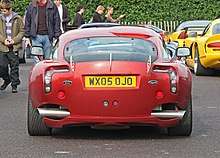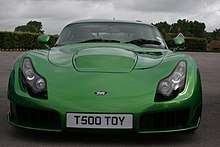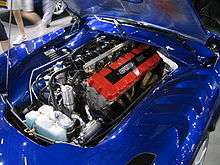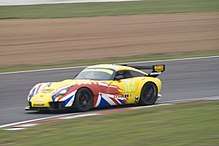TVR Sagaris
The TVR Sagaris is a sports car designed and built by the British manufacturer TVR in their factory in Blackpool, Lancashire.
| TVR Sagaris | |
|---|---|
_-_9576422793.jpg) | |
| Overview | |
| Manufacturer | TVR Motor Company Limited |
| Production | 2005–2006 |
| Assembly | Blackpool, England |
| Designer | Graham Browne Lee Hodgetts |
| Body and chassis | |
| Class | Sports car (S) |
| Body style | 2-door coupe |
| Layout | Longitudinal-mounted, front mid-engine, rear-wheel drive |
| Platform | Fibreglass body over tubular steel chassis |
| Related | TVR T350 |
| Powertrain | |
| Engine | 4.0 L (3,996 cc) Speed Six I6 |
| Power output | 406 bhp (412 PS; 303 kW) and 349 lb⋅ft (473 N⋅m) of torque |
| Transmission | 5-speed manual |
| Dimensions | |
| Wheelbase | 92.9 in (2,360 mm) |
| Length | 159.7 in (4,056 mm) |
| Width | 72.8 in (1,849 mm) |
| Height | 46.3 in (1,176 mm) |
| Curb weight | 2,376 lb (1,078 kg) |
| Chronology | |
| Successor | TVR Griffith (Second Generation) |
Overview


The Sagaris made its debut at the MPH03 Auto Show in 2003. The pre-production model was then shown at the 2004 Birmingham Motor Show. In 2005 the production model was released for public sale at TVR dealerships around the world. Based on the TVR T350,[1] the Sagaris was designed with endurance racing in mind. The multitude of air vents, intake openings and other features on the bodywork allow the car to be driven for extended periods of time on race tracks with no modifications required for cooling and ventilation. The final production model came with several variations from the pre-production show models e.g. the vents on the wings are not cut out, different wing mirrors, location of the fuel filler and bonnet hinges along with other variations.
As with all the TVRs of the 1990s and early 2000s, the Sagaris ignores the European Union guideline that all new cars should be fitted with ABS and at least front airbags because Peter Wheeler believed that such devices promote overconfidence and risk the life of a driver in the event of a rollover, which TVRs are engineered to resist.[2] It also eschews electronic driver's aids (such as traction control or electronic stability control).
The car's name comes from the sagaris, the Greek name of a lightweight battle-axe used by the Scythians which was feared for its ability to penetrate the armor of their enemies. The car was designed by Graham Browne.
Daniel Boardman was the Chief Engineer involved in the Sagaris project who was frustrated with well-known TVR quality issues such as water ingress, carpets coming unstuck and tricky handling, he spent considerable time ensuring the Sagaris was engineered properly from the start. The suspension was designed to eliminate bump-steer, the dampers were tuned with input from the Bilstein and Multimatic, the bonnet was redesigned to work as well as any conventional steel bonnet and door seals were meticulously checked to ensure no water ingress. Motoring journalist Jeremy Clarkson described the resulting product as "the best TVR ever made".
In 2008, TVR unveiled the Sagaris 2, which was designed to replace the original Sagaris. The prototype had minor changes to the original car including a revised rear fascia and exhaust system, and modifications to the interior.[3]
A company called Grex Automotive acquired the forms and tools after TVR's bankruptcy. In 2018 they made the TVR Sagaris available to buy as a kit car.[4] Only ten examples were planned, and the engine and transmission choice were up to the buyers.[4]
Specifications

Powerplant
- Engine type: Sagaris Tennis GH TVR Speed Six engine
- Displacement: 3,996 cc (4.0 L; 243.9 cu in)
- Power output: 406 bhp (303 kW; 412 PS) at 7000 rpm
- Torque output: 349 lb⋅ft (473 N⋅m) at 5000 rpm[5]
- Bore x stroke: 96 mm × 92 mm (3.78 in × 3.62 in)
- Compression ratio: 12.2:1
- Valvetrain setup: DOHC 4 valves per cylinder
- Camshaft duration: inlet 264, exhaust 264 standard
Gearbox
- Transmission: 5-speed manual
Suspension
- Front: Independent, double wishbones, coilover gas dampers, sway bars
- Rear: Independent, double wishbones, coil-over gas dampers, sway bars
- Front: 322 mm (12.7 in) ventilated disc brakes
- Rear: 298 mm (11.7 in) ventilated disc brakes
Wheels and tires
- Wheels: 18 x 8.5 in aluminium alloy Spider wheels
- Tires: 255/35 R18
Chassis/body
- Body panels: Glass Reinforced Plastic
- Weight: 2,371 lb (1,075 kg)
- Length: 4,057 mm (159.7 in)
- Width: 1,770 mm (69.7 in)
- Height: 1,175 mm (46.3 in)
Performance
Racing


The racing version of the TVR Sagaris was entered in the 2011 British GT Cup by Team Winstanley and driven by Danny Winstanley, the car in racing spec had a standard factory chassis but was fitted with the upgraded 420 hp (426 PS; 313 kW) TVR Supersport Speed Six engine. In its first season it recorded wins at Oulton Park and Brands Hatch.
Other Media
In the Xbox 360 video game Forza Horizon 2, a metallic purple 2005 Sagaris is the stock car, with 380 hp (385 PS; 283 kW). The car is also available in the sequel to Forza Horizon 2, Forza Horizon 3. The Sagaris featured in the 2011 video games Forza Motorsport 4 and Test Drive Unlimited 2 and the 2014 video game The Crew and its 2018 sequel The Crew 2. It also featured on the original Xbox in Project Gotham Racing 2.
The 2010 film The Heavy features a black TVR Sagaris driven by Gary Stretch.
References
- "TVR Sagaris | First Drives" March 2005, retrieved on 2009-05-08
- "The Wheeler Interview: Ted quizzes TVR's Chairman on ABS, airbags and safety" 18 April 2004, retrieved on 2009-01-31
- Wojdyla, Ben (11 July 2008). "TVR Reveals Sagaris 2 Prototype, Sending Fender Vent Futures Up Sharply On Early Morning Trading". Jalopnik.
- Östlund, Daniel. "Bygg din egen TVR Sagaris" [Build your own TVR Sagaris] (in Swedish). Byt bil. Retrieved 29 June 2019.
- "2003 TVR Sagaris". Carfolio.com. 28 February 2013. Retrieved 24 September 2018.
- "TVR Sagaris" TVR 2005, retrieved on 9 October 2009
- "TVR Sagaris" AutoCar UK 24 May 2005, retrieved on 2009-05-08